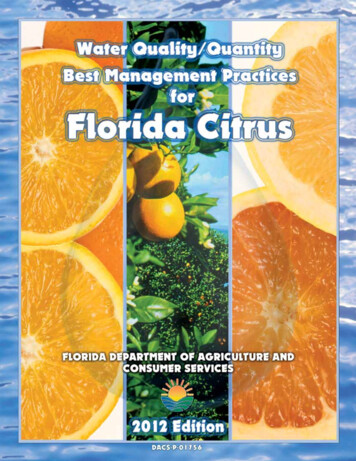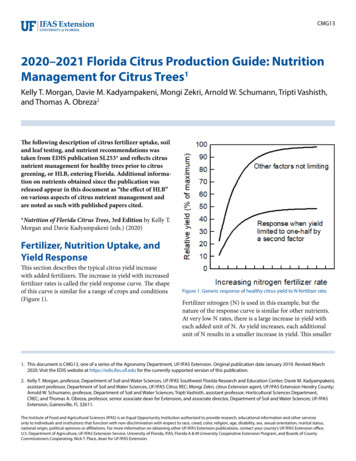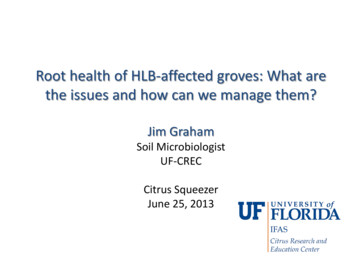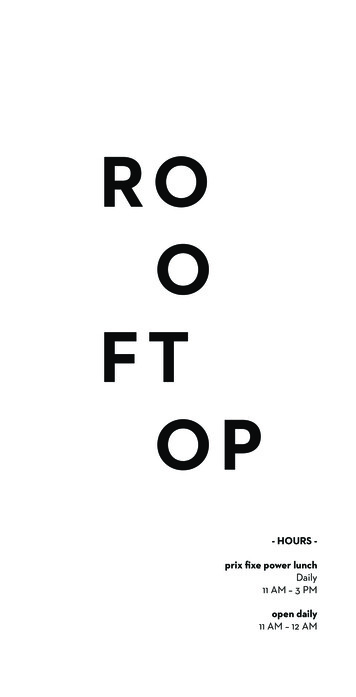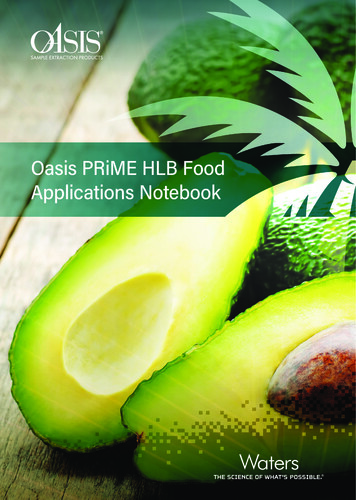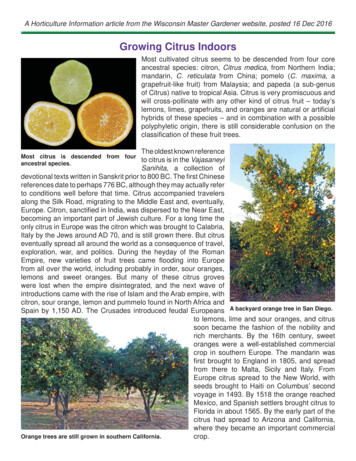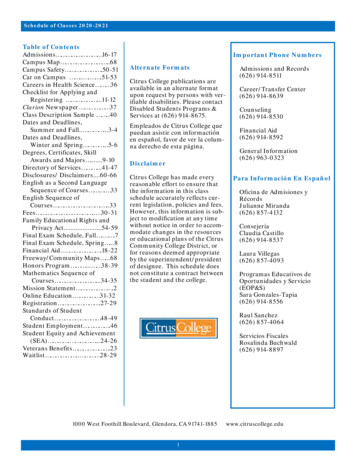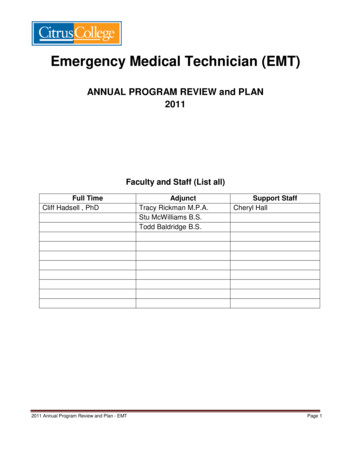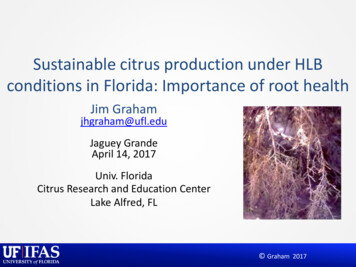
Transcription
Sustainable citrus production under HLBconditions in Florida: Importance of root healthJim Grahamjhgraham@ufl.eduJaguey GrandeApril 14, 2017Univ. FloridaCitrus Research and Education CenterLake Alfred, FL Graham 2017
HLB disrupts phloem sugar allocation to fruitcausing stem-end break-down and premature fruit drop
What has happened to FL citrus production?HLB 140-150HLB Effect703
Revenue and Cost per Acre for Processed Orangesin Central Florida (Ridge)3,5003,000 per acre2,5002,0001,5001,000500Revenue Non-ValenciaSource: University of Florida, CRECRevenue ValenciaTotal CostCultural Cost
Why does HLB cause such rapid crop loss?
30-50% fibrous root loss occurs before symptoms appear!HealthySymptomlessInfectedThinningHealthy roots30-50% root loss70-80% root loss
Impact of root damage: decline in Ca and Mg leaf status over4 year period while HLB incidence increased exponentially1.0%0.1%Data fromLykes Citrus
Early SeasonRoot loss is responsible for animmediate 30% yield declineLoss continues as trees further declineMid Season30%Late SeasonData From: Bassanezi et al. 2011European Journal of Plant Pathology
Measuring root growth with root cagesTake to labfor processingInstallRoot CagesUnder TreeCollectRoot CagesAfter 2 monthsSoil Coresat timeof cageharvest
New root growth is not inhibited by ity
Canopy thinning and erratic flushing and floweringWoody branches visibleSymptomatic new flushLeaf drop and dieback
HLB - Root Health Challenge: stabilizing root growth Carbohydrates (CHO) are required to build roots and supportwater and nutrient uptake and translocation HLB roots lacking CHO supply are less active and have a reducedlifespan In a given season of root production, higher root density supportsmore fruit retention at harvest The goal is to sustain root production on HLB trees bycounteracting abiotic (bicarbonates) and biotic (Phytophthora)stresses
Phytophthora species and their occurrence in Florida citrus Phytophthora nicotianae commoncause of foot rot and root rot Phytophthora palmivora causesbrown rot of fruit, root rot inpoorly drained soils with highwater tables (IR and SW) P. nicotianae is initially introducedinto virgin land by nursery stock P. palmivora is endemic in Floridaand enters groves from reservoirsin native vegetationP. palmivoraP. nicotianaeSporangia elongatedSporangia round
Phytophthora is in everygrove causing root lossdepending on season androot growth cycles Susceptibility of rootshighest during very wetto very dry cycles (springand fall) Wetting and dryingincreases root exudationattracts zoospores
Phytophthora interaction with Las-infected roots Roots infected by Liberibacter asiaticus (Las) are leaky and moreattractive to Phytophthora zoospores Roots tolerance to Phytophthora is broken by the Las infection Fungicides that induce resistance of roots to Phytophthora(Aliette, phosphites) or inhibit pathogen propagules(mefenoxam) work less well to reduce infection and root loss. HLB reduces tree's ability to respond to biotic stresses includingPhytophthora
Phytophthora populations increased with incidence of HLBNow populations fluctuate seasonally and annually withroot production cyclesPhytophthora populationAnnual root production1.4Root dry weight (g/sample)1.21.00.80.60.40.20.02013Data courtesy of John TaylorSyngenta Crop Protection201420152016 YTD
Soil and water bicarbonates reduce tolerance of rootsto stress and exacerbate HLB symptom expression Micro-irrigation loads bicarbonates in the wetted zone whereroots are concentrated under the tree Bicarbonate reduces root uptake of Ca, Mg, Fe, Zn, Mn Orchards under bicarbonate stress experience deterioration offibrous root density, lifespan and function in nutrient uptake Important FL rootstocks are more sensitive to bicarbonates:Swingle citrumelo Carrizo citrange Sour orange Cleopatramandarin Soil pH 6.5 in wetted zone associated with irrigation waterhigh in bicarbonate ( 100 ppm) higher HLB expression (i.e.fruit drop)
Bicarbonates reduce root density and nutrient uptakeLower density is related to well water pH 6.5, soil pH 6.2Well water pHSoil pH in the wetted zone1.0r2 0.500.83Fibrous root density (mg/cm )Fibrous root density (mg/cm 3)1.00.60.40.20.03456Well water pH789r2 0.250.80.60.40.20.04.55.05.56.0Soil pH6.57.07.5
Health and fruit drop for 6 yr old Valencia/Swingle treesTrees under bicarbonate stress have 20% lower root densitySoil pH 6.4: Fruit drop minimal Soil pH 7.2: Fruit drop resulted in early harvest
Managing soil/water quality stresses Balanced, lower duration and more frequent application ofwater and nutrients to the reduced root system Reducing soil pH/bicarbonate stress sustains root function innutrient and water uptake and tolerance to Phytophthora To assess bicarbonate stress :- check soil pH in wetted zone- test well water for pH, bicarbonates, salinity, cations, anions Water conditioning: Inject N-phuric acid or sulfuric acid (40%) toreduce irrigation water to 100 ppm bicarbonate Soil conditioning: broadcast sulfur in wetted zone to reduce pH
Acidification of soil and/or water reduces root zone pHand releases Ca and Mg for root uptakeIrrigation Water Conditioning Faster actingSoil conditioning with S Slower acting300 lbs/treated acre of elemental sulfurlowered soil pH in 9 monthsValencia/Swingle - 10 yr oldSulfurpHRoot density(mg/cm3)No6.41.1Yes5.9*1.4** Significant difference P 0.05
Results of acidification with sulfur amendment andacidified fertigation after 3 seasons 150 lb Sulfur & 3.0 gal N-phuric acid/ton liquid fertilizer peracre per season (50% dry and 50% liquid)20142015Soil pH7.06.7Soil Ca (lb/acre)22833010Soil Mg (lb/acre) 118107Leaf Ca (%)3.14.5*Leaf Mg (%)0.330.32* Significant difference at P 0.05; Mean of 20-22 blocks A 9% increase in production from 2014-2015
Valencia/Swingle trees 8 yrs oldafter 3.5 yrs of water acidification2015 2016 production up 20%
Davis 2012-20152000190Soil Ca (Lbs/A)18018001701700160160015015001401400Soil Mg (Lbs/A)CaMg19001302012201320142015YearDavis 2012-2015CaMgLeaf Ca 014Year2015Leaf Mg (%)4.4HLB increases need for soilapplication of Ca and Mg Calcium sulfate –1 ton/acre/year in 2 applications Magnesium sulfate (Epsom salts) Ca & Mg in dolomite lime ifpH 6.0, bicarbonate 100 ppm
Increased tree growth and yield with best managementpractices using liquid fertilization/acidification5 yr old trees9 yr old treesValenciaSouth Central FL 2016
nutrient and water uptake and tolerance to Phytophthora To assess bicarbonate stress : - check soil pH in wetted zone - test well water for pH, bicarbonates, salinity, cations, anions Water conditioning: Inject N-phuric acid or sulfuric acid (40%) to reduce irrigation water to 100 ppm bicarbonate
